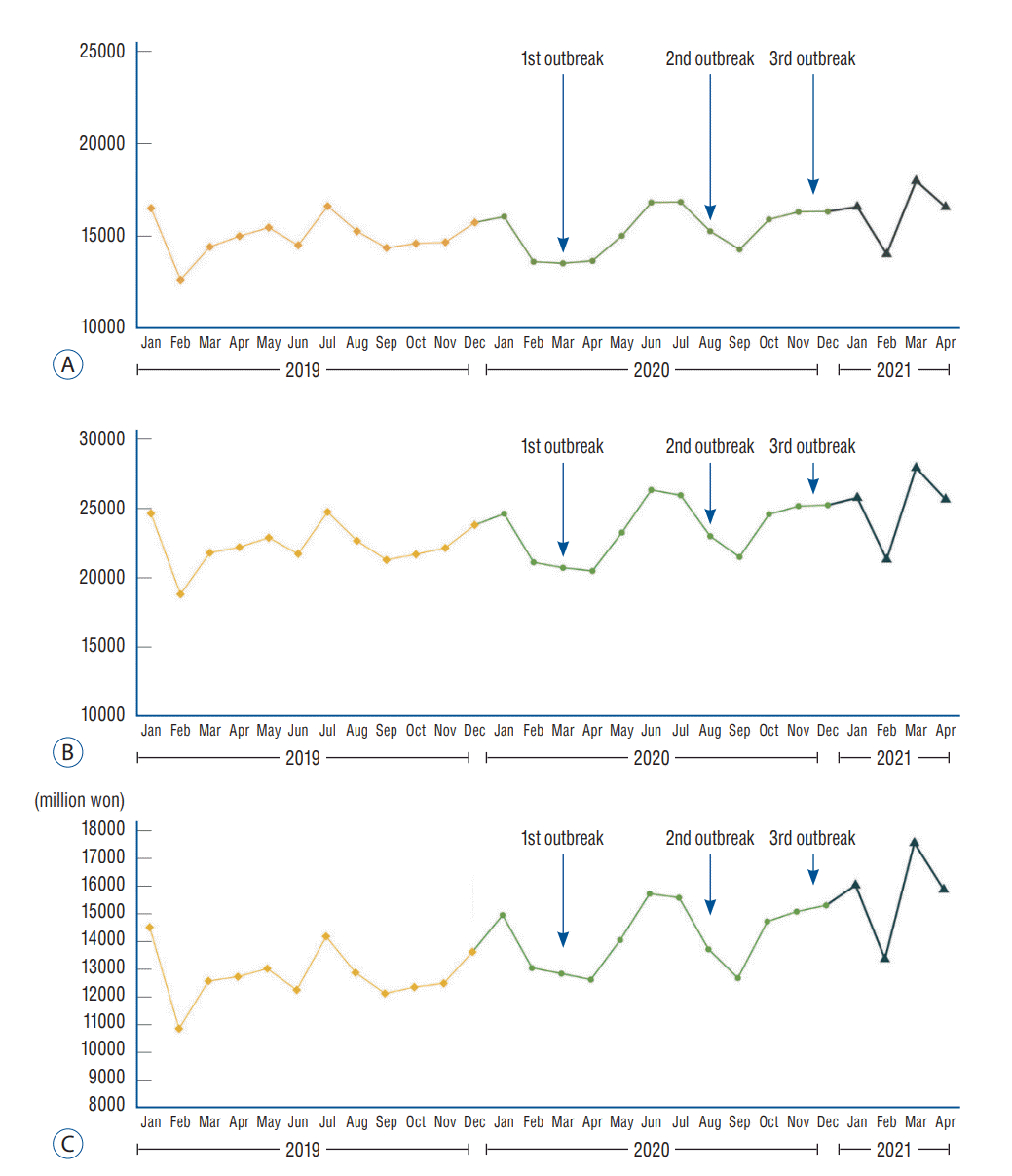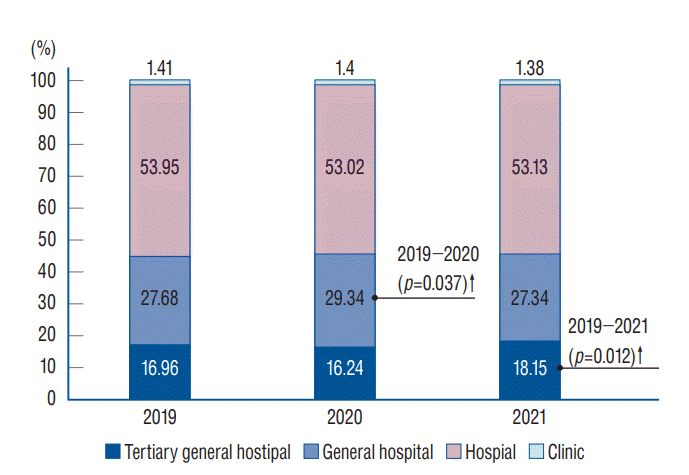2. Bregman DE, Cook T, Thorne C. Estimated national and regional impact of COVID-19 on elective case volume in aesthetic plastic surgery. Aesthet Surg J. 41:358–369. 2021.
3. Carlos WG, Dela Cruz CS, Cao B, Pasnick S, Jamil S. Novel Wuhan (2019-nCoV) coronavirus. Am J Respir Crit Care Med. 201:P7–P8. 2020.
5. Chang DG, Park JB, Baek GH, Kim HJ, Bosco A, Hey HWD, et al. The impact of COVID-19 pandemic on orthopaedic resident education: a nationwide survey study in South Korea. Int Orthop. 44:2203–2210. 2020.
6. Chapon R, Meyblum J, Simon L, Pelletier Y, Broussolle T, Marty H, et al. Global French Spine Surgery Activity: Executive Report of Demographics Data and Trends. Available at :
https://doi.org/10.21203/rs.3.rs-1260367/v1.
7. Choi JY. COVID-19 in South Korea. Postgrad Med J. 96:399–402. 2020.
8. GBD 2015 Disease and Injury Incidence and Prevalence Collaborators. Global, regional, and national incidence, prevalence, and years lived with disability for 310 diseases and injuries, 1990-2015: a systematic analysis for the Global Burden of Disease Study 2015. Lancet. 388:1545–1602. 2016.
9. Ham CH, Moon HJ, Kim JH, Park YK, Lee TH, Kwon WK. Coronavirus disease (COVID-19) outbreak and its impact on spinal daily practice : preliminary report from a single (regional) university hospital in Republic of Korea. J Korean Neurosurg Soc. 63:407–414. 2020.
11. Hussain A, Mahawar K, El-Hasani S. The impact of COVID-19 pandemic on obesity and bariatric surgery. Obes Surg. 30:3222–3223. 2020.
12. Jain NS, Alluri RK, Schopler SS, Hah R, Wang JC. COVID-19 and spine surgery: a review and evolving recommendations. Global Spine J. 10:528–533. 2020.
13. Lauer SA, Grantz KH, Bi Q, Jones FK, Zheng Q, Meredith HR, et al. The incubation period of coronavirus disease 2019 (COVID-19) from publicly reported confirmed cases: estimation and application. Ann Intern Med. 172:577–582. 2020.
14. Lee MH, Jang SR, Lee TK. Comparative analysis of COVID-19 outbreak and changes in neurosurgical emergency patients. J Korean Neurosurg Soc. 65:130–137. 2022.
15. Li LQ, Huang T, Wang YQ, Wang ZP, Liang Y, Huang TB, et al. COVID-19 patients' clinical characteristics, discharge rate, and fatality rate of meta-analysis. J Med Virol. 92:577–583. 2020.
16. Mackay ND, Wilding CP, Langley CR, Young J. The impact of COVID-19 on trauma and orthopaedic patients requiring surgery during the peak of the pandemic: a retrospective cohort study. Bone Jt Open. 1:520–529. 2020.
17. Noureldine MHA, Pressman E, Krafft PR, Greenberg MS, Agazzi S, van Loveren H, et al. Impact of the COVID-19 pandemic on neurosurgical practice at an academic tertiary referral center: a comparative study. World Neurosurg. 139:e872–e876. 2020.
18. O'Connell RM, Khan MA, Amir M, Bucheeri M, Khan W, Khan IZ, et al. The impact of COVID-19 on emergency general surgery admissions and operative volumes: a single centre experience. Surgeon. 19:e207–e212. 2021.
19. Okuno T, Takada D, Shin JH, Morishita T, Itoshima H, Kunisawa S, et al. Impact of the coronavirus disease 2019 pandemic on surgical volume in Japan: a cohort study using administrative data. Available at :
https://doi.org/10.1101/2020.11.18.20233882.
20. Ozoner B, Gungor A, Hasanov T, Toktas ZO, Kilic T. Neurosurgical practice during coronavirus disease 2019 (COVID-19) pandemic. World Neurosurg. 140:198–207. 2020.
21. Prost S, Charles YP, Allain J, Barat JL, d'Astorg H, Delhaye M, et al. French Spine Surgery Society guidelines for management of spinal surgeries during COVID-19 pandemic. World J Clin Cases. 8:1756–1762. 2020.
22. Rocco B, Sighinolfi MC, Sandri M, Altieri V, Amenta M, Annino F, et al. The dramatic COVID 19 outbreak in Italy is responsible of a huge drop of urological surgical activity: a multicenter observational study. BJU Int. 127:56–63. 2021.
24. Sarac NJ, Sarac BA, Schoenbrunner AR, Janis JE, Harrison RK, Phieffer LS, et al. A review of state guidelines for elective orthopaedic procedures during the COVID-19 outbreak. J Bone Joint Surg Am. 102:942–945. 2020.
25. Saraswathula A, Gourin CG, Stewart CM. National trends in US otolaryngology surgical volume during the early COVID-19 pandemic. JAMA Otolaryngol Head Neck Surg. 147:397–399. 2021.
26. Soh TLT, Ho SWL, Yap WMQ, Oh JY. Spine surgery and COVID-19: challenges and strategies from the front lines. J Bone Joint Surg Am. 102:e56. 2020.
27. Stinner DJ, Lebrun C, Hsu JR, Jahangir AA, Mir HR. The orthopaedic trauma service and COVID-19: practice considerations to optimize outcomes and limit exposure. J Orthop Trauma. 34:333–340. 2020.
28. Tanaka M, Kanayama M, Hashimoto T, Oha F, Shimamura Y, Tsujimoto T, et al. Trends of spine surgeries during the first COVID-19 semilockdown: survey in a non-epidemic region in Japan. Spine Surg Relat Res. 6:109–114. 2022.
29. The North American Spine Society : NASS Guidance Document on Elective, Emergent and Urgent Procedures. Available at :
https://www.spine.org/COVID-19.
30. Wölfel R, Corman VM, Guggemos W, Seilmaier M, Zange S, Müller MA, et al. Virological assessment of hospitalized patients with COVID-2019. Nature. 581:465–469. 2020.
32. Wordie SJ, Tsirikos AI. The impact of the COVID-19 pandemic on spinal surgery. Orthop Trauma. 35:314–320. 2021.






 PDF
PDF Citation
Citation Print
Print



 XML Download
XML Download